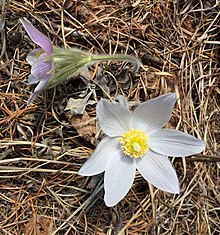Pulsatilla
| Pulsatilla | |
|---|---|

| |
| Pulsatilla vulgaris | |
| Scientific classification | |
| Kingdom: | Plantae |
| Clade: | Tracheophytes |
| Clade: | Angiosperms |
| Clade: | Eudicots |
| Order: | Ranunculales |
| Family: | Ranunculaceae |
| Subfamily: | Ranunculoideae |
| Tribe: | Anemoneae |
| Genus: | Pulsatilla Mill. |
| Synonyms[1] | |
| |
The genus Pulsatilla contains about 40 species of herbaceous perennial plants native to meadows and prairies of North America, Europe, and Asia. Derived from the Hebrew word for Passover, "pasakh", the common name pasque flower refers to the Easter (Passover) flowering period, in the spring.[2][3] Common names include pasque flower (or pasqueflower), wind flower, prairie crocus, Easter flower, and meadow anemone. Several species are valued ornamentals because of their finely-dissected leaves, solitary bell-shaped flowers, and plumed seed heads. The showy part of the flower consists of sepals, not petals.
Taxonomy
The genus Pulsatilla was first formally named in 1754 by the English botanist Philip Miller. The type species is Pulsatilla vulgaris[4], the European pasque flower.
It is sometimes considered a subgenus under the genus Anemone or as an informally named "group" within Anemone subg. Anemone sect. Pulsatilloides.[5]
Species


As of April 2020[update], Kew's Plants of the World Online lists 42 species in the genus Pulsatilla:[1]
- Pulsatilla ajanensis Regel & Tiling
- Pulsatilla albana (Steven) Bercht. & J.Presl
- Pulsatilla alpina (L.) Delarbre
- Pulsatilla ambigua (Turcz. ex Hayek) Zämelis & Paegle
- Pulsatilla aurea (Sommier & Levier) Juz.
- Pulsatilla bungeana C.A.Mey.
- Pulsatilla campanella (Regel & Tiling) Fisch. ex Krylov
- Pulsatilla cernua (Thunb.) Bercht. & J.Presl
- Pulsatilla chinensis (Bunge) Regel
- Pulsatilla dahurica (Fisch. ex DC.) Spreng.
- Pulsatilla georgica Rupr.
- Pulsatilla grandis Wender.
- Pulsatilla halleri (All.) Willd.
- Pulsatilla herba-somnii Stepanov
- Pulsatilla integrifolia (Miyabe & Tatew.) Tatew. & Ohwi ex Vorosch.
- Pulsatilla koreana
- Pulsatilla kostyczewii (Korsh.) Juz.
- Pulsatilla magadanensis A.P.Khokhr. & Vorosch.
- Pulsatilla millefolia (Hemsl. & E.H.Wilson) Ulbr.
- Pulsatilla montana (Hoppe) Rchb.
- Pulsatilla multiceps Greene
- Pulsatilla nipponica (H.Takeda) Ohwi
- Pulsatilla nuttalliana (DC.) Spreng.
- Pulsatilla occidentalis (S.Watson) Freyn
- Pulsatilla orientali-sibirica Stepanov
- Pulsatilla patens (L.) Mill.
- Pulsatilla pratensis (L.) Mill.
- Pulsatilla reverdattoi Polozhij & A.T.Malzeva
- Pulsatilla rubra (Lam.) Delarbre
- Pulsatilla sachalinensis H.Hara
- Pulsatilla scherfelii (Ullep.) Skalický
- Pulsatilla sukaczewii Juz.
- Pulsatilla taraoi (Makino) Zämelis & Paegle
- Pulsatilla tatewakii Kudô
- Pulsatilla tenuiloba (Turcz.) Juz.
- Pulsatilla tongkangensis Y.N.Lee & T.C.Lee
- Pulsatilla turczaninovii Krylov & Serg.
- Pulsatilla usensis Stepanov
- Pulsatilla vernalis (L.) Mill.
- Pulsatilla violacea Rupr.
- Pulsatilla vulgaris Mill.
- Pulsatilla wallichiana (Royle) Ulbr.
- Pulsatilla zimmermannii Soó
Plants of the World Online lists ten named hybrids:[1]
- Pulsatilla × bolzanensis Murr
- Pulsatilla × celakovskyana Domin
- Pulsatilla × emiliana (F.O.Wolf) Beauverd
- Pulsatilla × gayeri Simonk.
- Pulsatilla × girodii (Rouy) P.Fourn.
- Pulsatilla × hackelii Pohl
- Pulsatilla × knappii (Palez.) Palez.
- Pulsatilla × weberi (Widder) Janch. ex Holub
- Pulsatilla × wilczekii (F.O.Wolf ex Hegi) P.Fourn.
- Pulsatilla × yanbianensis H.Z.Lv
Cultural significance
Pulsatilla nuttalliana (as the synonym P. patens) is the provincial flower of Manitoba, Canada[6] and (as the synonym P. hirsutissima) the state flower of the US state of South Dakota.[7] Pulsatilla vulgaris is the County flower for both Hertfordshire and Cambridgeshire in England.[8] Pulsatilla vernalis is the county flower of Oppland, Norway. The UK has introduced the UK biodiversity action plan to address the 49% decline in wild Pulsatilla species.[2]
Use and toxicity
Pulsatilla is a toxic plant. Misuse can lead to diarrhea, vomiting and convulsions,[9] hypotension, and coma.[10] It has been used as a medicine by Native Americans for centuries. Blackfoot Indians used it to induce abortions and childbirth. Pulsatilla should not be taken during pregnancy nor during lactation.[11]
Extracts of Pulsatilla have been used to treat reproductive problems such as premenstrual syndrome and epididymitis.[11] Additional applications of plant extracts include uses as a sedative and for treating coughs.[11] It is also used in the field of homeopathy.[11]
References
- ^ a b c "Pulsatilla". Plants of the World Online. Royal Botanic Gardens, Kew. Retrieved 13 March 2022.
- ^ a b Fowler, Alys. (March 2005). "Pulsatilla". Horticulture Week; Teddington. 20. ProQuest 225454561.
- ^ "Prairie Pasque". South Dakota Magazine. April 6, 2016. Retrieved April 7, 2016.
- ^ "Pulsatilla Mill". ipni.org. International Plant Names Index. Retrieved 26 April 2020.
- ^ Hoot, S. B., J. D. Palmer, and A. A. Reznicek. 1994. Phylogenetic relationships in Anemone based on morphology and chloroplast DNA variation. Systematic Botany 19: 169–200. hdl:2027.42/105541
- ^ Government of Manitoba. "Symbols of Manitoba". Archived from the original on 2005-12-10. Retrieved 2011-04-10.
- ^ Chapter 1 2005 South Dakota Legislative Manual The Mount Rushmore State
- ^ Plantlife website County Flowers page Archived 2015-04-30 at the Wayback Machine
- ^ Edible and Medicinal plants of the West, Gregory L. Tilford, ISBN 0-87842-359-1
- ^ Yarnell, E. and Abascal, K. (2001) Botanical Treatments for Depression: Part 2 - Herbal Corrections for Mood Imbalances
- ^ a b c d Vaughan, John Griffith; Patricia Ann Judd; David Bellamy (2003). The Oxford Book of Health Foods. Oxford University Press. pp. 127. ISBN 978-0-19-850459-7.
pulsatilla.
- Anemone pulsatilla, Wildflowers index, Department of Horticultural Science of NC State University
- Gregory L. Tilford 1997. Edible and Medicinal plants of the West, Mountain Press Publishing ISBN 0-87842-359-1 preview
- [1] - "Pasqueflower (Pulsatilla vulgaris) Local species action plan for Cambridgeshire, 1999"
